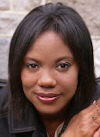|
Most of us read fiction to enjoy
the experience of being transported to another world through characters
who are familiar in some way or whose lives are so different from our
own that we’re enthralled.
Multicultural novels offer the
added advantage of introducing characters that may not look like, talk
like, think like, or live like the readers who come to know them.
When readers are intrigued (and
sometimes brave) enough to pick up a book that features people from a
culture or race different from their own, or with a plot that delves
into issues as foreign to them as another nation, they’re often
rewarded by a story that enriches their lives.
Simply put, every time any of
us—readers and writers alike—venture outside our comfort zones or
familiar territory without judgment or fear, we inevitably become wiser
and better people.
Christian fiction authors
leading this charge include Sharon Ewell Foster, Marilynn Griffith,
Camy Tang, Claudia Mair Burney, Lisa Samson, and Linda Leigh Hargrove,
whose characters range from Native American to biracial, with personal
issues that span life’s spectrum.
Great books leave readers
rooting for characters they’ve connected with and wishing the worst for
the protagonists’—and their own—fictional enemies. The bond is deepened
chapter by chapter as readers learn what makes a character strong or
weak, timid or rebellious, tied to religious rituals or skeptical about
God.
In the proverbial “melting pot”
of creativity, authors get to pick and choose more than hair color and
skin tone, or the shape of a nose and uniqueness of an accent; they
develop characters and build scenes that resonate with readers.
Some authors intentionally craft
novels so that the cultural implications of a character’s existence are
woven into every aspect of the story. Others allow differences between
characters to be matter of fact, eliminating the need to announce their
presence.
Either way, multicultural
fiction can unwittingly help readers recreate the understanding and
kinship discovered in a book in their own lives.
In novels like the mainstream
best-sellers The Color Purple, The Secret Life of Bees,
and The Joy Luck Club, where the characters’
personalities or compelling
|
circumstances transcend an
emphasis on
race, gender, or physical shortcomings, readers are drawn to the
protagonists’ hearts.
Once that happens, the
characters’ obvious differences serve as little more than a backdrop.
And readers realize that if they can embrace fictional people unlike
themselves, it isn’t too far of a leap for them to do the same with
their neighbors or maybe even strangers.
For Christian fiction writers
whose books are infused with multicultural elements, the goal is not
unlike that of other authors: to create the most compelling and
authentic storylines and characters possible, and through that process,
draw others to Christ.
However, we also work to create
characters who, at the end of the book, value their friendship and
mutual admiration more than their differences. The path to this
realization isn’t always smooth or comfortable, but as in real life,
it’s usually worthwhile.
We paint word pictures of
vibrant fictional people who aren’t cookie-cutter clones of what
Christians should be but instead reflect the vast representation of
people across the world who love God or are struggling to know Him
better. Because the truth is we don’t all look alike, talk alike, think
alike, or live alike, yet we all have the same opportunity to
experience the Master’s transforming love.

|










